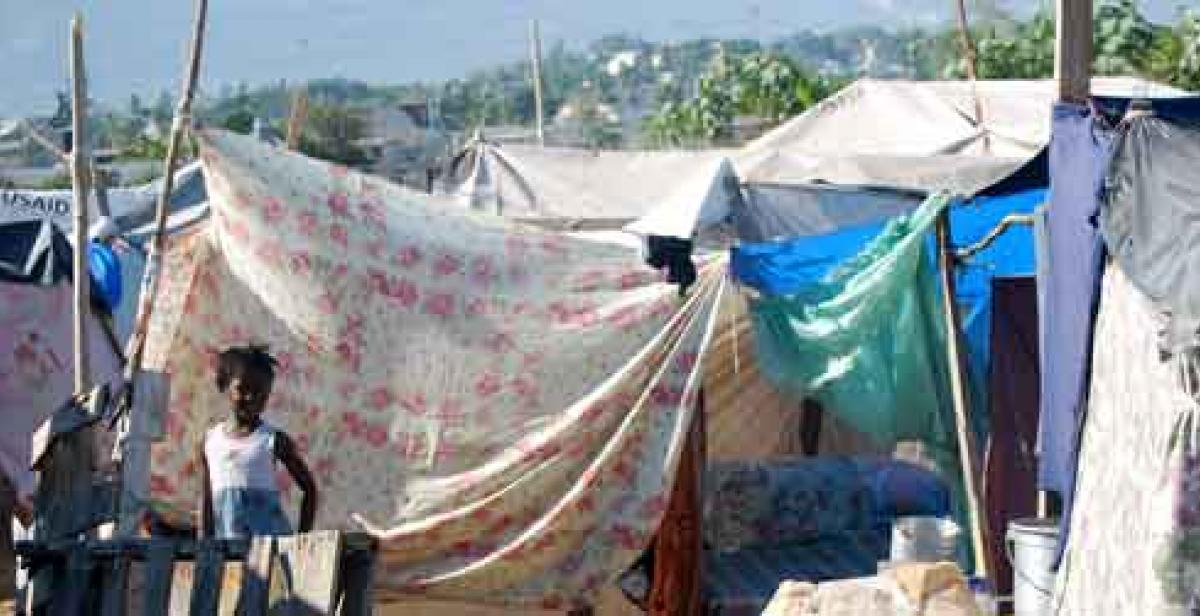In some parts of Port au Prince every second building has been flattened. Five months since the quake hit, the scene is still horrific. Three storey blocks have been reduced to two. Or one. Concrete shells of former houses, or shops, or offices, perch on piles of rubble, lop-sided, as if they might roll on to the pavement or into the road. Precarious looking staircases, which would have once occupied the central atrium of buildings, hang metres off the ground. Many homes have been ripped in half – spilling bedrooms and bathrooms, complete with twisted shower heads and smashed headboards, on the streets of this dusty, noisy, busy city.
It’s not a sight you get used to. Around every corner, just when you’ve thought you’ve seen it all, there’s something worse. Five storeys, obliterated. Or a group of people pulling bones from a former school that was packed with students when the quake struck. There are simply no words to describe the horror of it all. To think what it would have been like here on the 12th of January, or “le douze” as Haitians call it, makes you shudder.
But what really makes you shudder is this: after months of international aid, UN assistance, public appeals, high-level summits and agreements and plans and road maps, are the conditions for hundreds of thousands of Haitians in the huge, sprawling camps.
Many of these tent cities sprung up just a day or two after January 12. According to some, there are now more than 1000 in and around Port au Prince alone. For the most part, they provide no electricity, running water or food for their inhabitants who live side by side for as far as they eye can see, like sardines in a tin. Inside each plastic ‘home’, temperatures can probably rise to 50 degrees centigrade or more. In some cases, entire families share one bed. The rains, which now come almost every afternoon, send water gushing across the floor, soaking what few belongings people have acquired or managed to salvage.
One lady we meet in a camp run by the Jesuit Refugee and Migrant Service, Adeline Julien, 56, tells us that she can’t go into her tent during the day. “It’s far too hot in there”, she says. “I have to spend the day outside instead.” But ‘outside’ isn’t much better – the beating sun is almost as piercing as the oven-like heat under Adiline’s canvas bubble.
The real shock, though, is that most of these people are not poor, uneducated, slum dwellers who are used to life with nothing – which is not to say that this miserable existence is acceptable for anyone, regardless of how they lived before January 12. In Henfrasal, the same Jesuit run camp, we ask one lady exactly who is living in the sea of tents. “Nurses, accountants, teachers, secretaries….” she says, pointedly, as if to emphasize that these people are not used to such squalor, nor should they be.
Then I ask another man, Noel, where he lived before coming to Henfrasal. Thanks to a translation hiccup, he thinks I am asking if he lived in this camp before the earthquake hit. “No! Of course not!” he says, looking somewhat insulted. I quickly correct myself. “Pardon”, I say. “Where did you live before the quake?”. “In my house”, he says, pointing to a building just a few hundred metres away. It was ripped in two by the tremor. And so, he and his brothers and sisters had to move out. They are now all living in tents – including his 3 month old nephew who lies in the sun in a plastic washing up bowl, smiling, as we chat.
People here have no sense of when Port au Prince’s camps might be pulled down. A year, two years, five. Nobody knows. As Felix, a Jesuit Priest working with the Refugee and Migrant Service tells us, what people could really do with is a little joy in their lives. A few big screens, so people can watch the World Cup, would do wonders for morale, he says. Even if it’s just for a few weeks.




Comments
It's a shocking juxtaposition
It's a shocking juxtaposition - a big screen but no water, food and electricity - opium of the masses surely?
But the priest's pragmatism is borne of knowing those he's working with very well. Football as faith, something to hold on to together, a bit of light relief from the nearly unendurable.
When the crisis is as bad as Haiti's; relief, both financial and literal, seems the only option. No matter how much work has been done by organisations like Progressio to try to strengthen communities to take control of their lives, some things on some occasions, are just well beyond their reach.
What could make one angry (if one turned off the football) is that those who do have the reach are not using it well. If the Haitian government and the international community are not capable of getting food, water and electricity to the Haitian people five months after the quake, what hope is there of a telly?
Clare Jeffery
Progressio contributor
At the time of the Haiti
At the time of the Haiti quake, millions of pounds were given in aid, the US military mobilised? What went wrong? Why - under those circumstances - are people still existing in such dreadful conditions? And how can that situation be changed?
What's truly shocking here is to think of yourself in these people's shoes: a professional person with a home one day, a desperate refugee the next. How long will it take to turn this situation around for people who are just like us, indeed could be us?